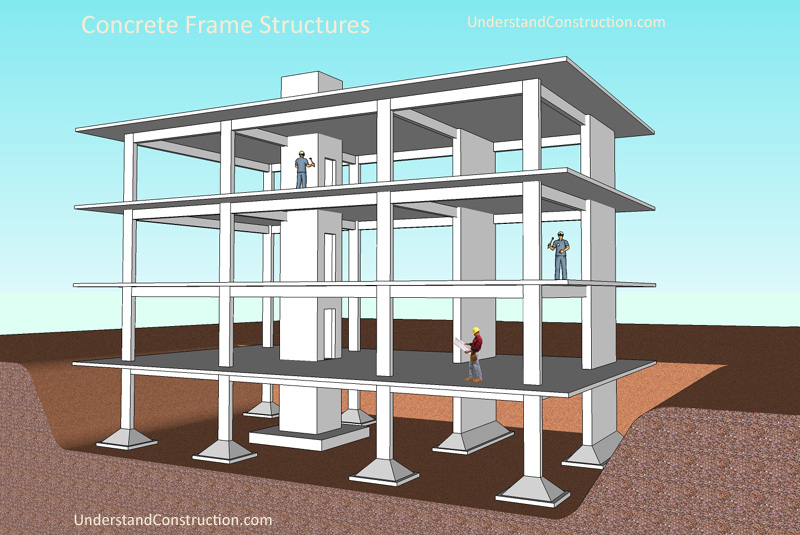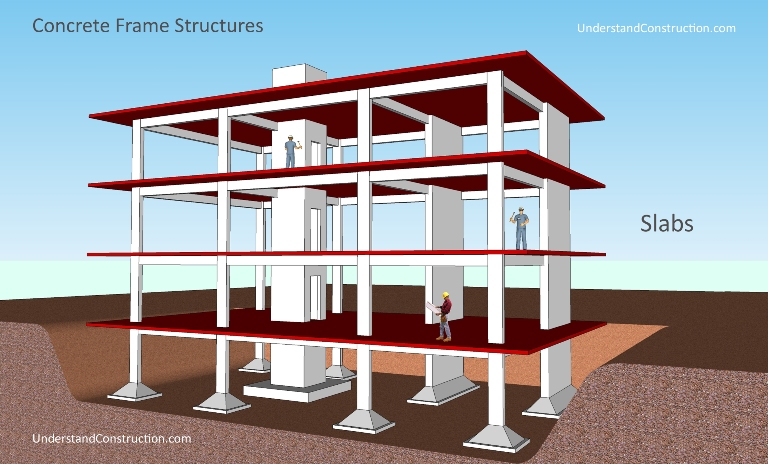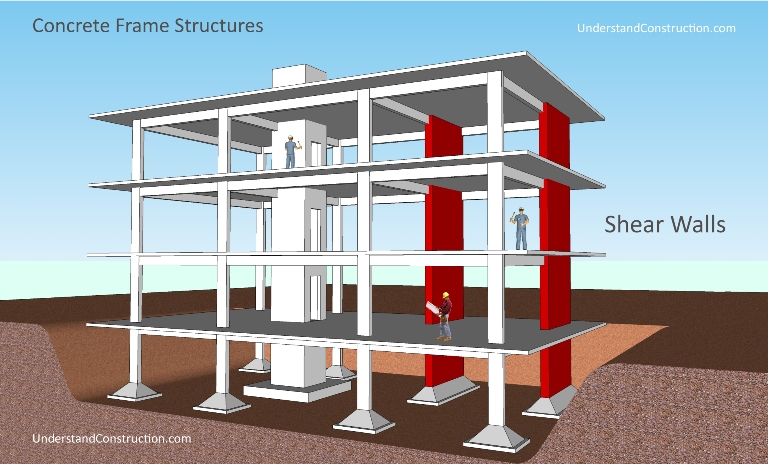Concrete frame structures are a very common - or perhaps the most common- type of modern building. As the name suggests, this type of building consists of a frame or skeleton of concrete. Horizontal members of this frame are called beams, and vertical members are called columns. Humans walk on flat planes of concrete called slabs. Of these, the column is the most important, as it is the primary load-carrying element of the building (See figure 2 at the bottom of the page for an illustration of each of the major parts of a frame structure). If you damage a beam in a building, it will usually affect only one floor, but damage to a column could bring down the entire building.

When we say concrete in the building trade, we actually mean reinforced concrete. Its full name is reinforced cement concrete, or RCC. RCC is concrete that contains steel bars, called reinforcement bars, or rebars. This combination works very well, as concrete is very strong in compression, easy to produce at site, and inexpensive, and steel is very very strong in tension. To make reinforced concrete, one first makes a mould, called formwork, that will contain the liquid concrete and give it the form and shape we need. Then one looks at the structural engineer's drawings and places in the steel reinforcement bars, and ties them in place using wire. The tied steel is called a reinforcement cage, because it is shaped like one. Once the steel is in place, one can start to prepare the concrete, by mixing cement, sand, stone chips in a range of sizes, and water in a cement mixer, and pouring in the liquid concrete into the formwork tilll exactly the right level is reached. The concrete will become hard in a matter of hours, but takes a month to reach its full strength. Therefore it is usually propped up until that period. During this time the concrete must be cured, or supplied with water on its surface, which it needs for the chemical reactions within to proceed properly.
Working out the exact 'recipe', or proportions of each ingredient, is a science in itself. It is called concrete mix design. A good mix designer will start with the properties that are desired in the mix, then take many factors into account, and work out a detailed mix design. A site engineer will often order a different type of mix for a different purpose. For example, if he is casting a thin concrete wall in a hard-to-reach area, he will ask for a mix that is more flowable than stiff. This will allow the liquid concrete to flow by gravity into every corner of the formwork. For most construction applications, however, a standard mix is used. Common examples of standard mixes are M20, M30, M40 concrete, where the number refers to the strength of the concrete in n/mm2 or newtons per square millimeter. Therefore M30 concrete will have a compressive strength of 30 n/mm2. A standard mix may also specify the maximum aggregate size. Aggregates are the stone chips used in concrete. If an engineer specifies M30 / 20 concrete, he wants M30 concrete with a maximum aggregate size of 20mm. He does NOT want concrete with a strength of between 20-30 n/mm2, which is a common misinterpretation in some parts of the world.
So the structure is actually a connected frame of members, each of which are firmly connected to each other. In engineering parlance, these connections are calledmoment connections, which means that the two members are firmly connected to each other. There are other types of connections, including hinged connections, which are used in steel structures, but concrete frame structures have moment connections in 99.9% of cases. This frame becomes very strong, and must resist the various loads that act on a building during its life.These loads include:- Dead Loads: the downwards force on the building coming from the weight of the building itself, including the structural elements, walls, facades, and the like.
- Live Loads: the downwards force on the building coming from the expected weight of the occupants and their possessions, including furniture, books, and so on. Normally these loads are specified in building codes and structural engineers must design buildings to carry these or greater loads. These loads will vary with the use of the space, for example, whether it is residential, office, industrial to name a few. It is common for codes to require live loads for residential to be a minimum of about 200 kg/m2, offices to be 250 kg/m2, and industrial to be 1000 kg/m2, which is the same as 1T/m2. These live loads are sometimes called imposed loads.
- Dynamic Loads: these occur commonly in bridges and similar infrastructure, and are the loads created by traffic, including braking and accelerating loads.
- Wind Loads: This is a very important design factor, especially for tall buildings, or buildings with large surface area. Buildings are designed not to resist the everyday wind conditions, but extreme conditions that may occur once every 100 years or so. These are called design windspeeds, and are specified in building codes. A building can commonly be required to resist a wind force of 150 kg/m2, which can be a very significant force when multiplied by the surface area of the building.
- Earthquake Loads: in an earthquake, the ground vigorously shakes the building both horizontally and vertically, rather like a bucking horse shakes a rider in the sport of rodeo. This can cause the building to fall apart. The heavier the building, the greater the force on it. Its important to note that both wind and earthquake imposehorizontal forces on the building, unlike the gravity forces it normally resists, which are vertical in direction.
The concrete frame rests on foundations, which transfer the forces - from the building and on the building - to the ground. Some other important components of concrete frame structures are:
Shear Walls are important structural elements in high-rise buildings. Shear walls are essentially very large columns - they could easily measure 400mm thick by 3m long - making them appear like walls rather than columns. Their function in a building is to help take care of horizontal forces on buildings like wind and earthquake loads. Normally, buildings are subject to vertical loads - gravity. Shear walls also carry vertical loads. It is important to understand that they only work for horizontal loads in one direction - the axis of the long dimension of the wall. These are usually not required in low-rise structures.
Elevator Shafts are vertical boxes in which the elevators move up and down - normally each elevator is enclosed in its own concrete box. These shafts are also very good structural elements, helping to resist horizontal loads, and also carrying vertical loads.
walls in concrete frame buildings
Concrete frame structures are strong and economical. Hence almost any walling materials can be used with them. The heavier options include masonry walls of brick, concrete block, or stone. The lighter options include drywall partitions made of light steel or wood studs covered with sheeting material. The former are used when strong, secure, and sound-proof enclosures are required, and the latter when quick, flexible lightweight partitions are needed.When brick or concrete blocks are used, it is common to plaster the entire surface - brick and concrete - with a cement plaster to form a hard, long-lasting finish. cladding of concrete frame structures
Concrete frame buildings can be clad with any kind of cladding material. Common cladding materials are glass, aluminum panels, stone sheets, and ceramic facades. Since these structures can be designed for heavy loading, one could even clad them in solid masonry walls of brick or stone.




No comments:
Post a Comment